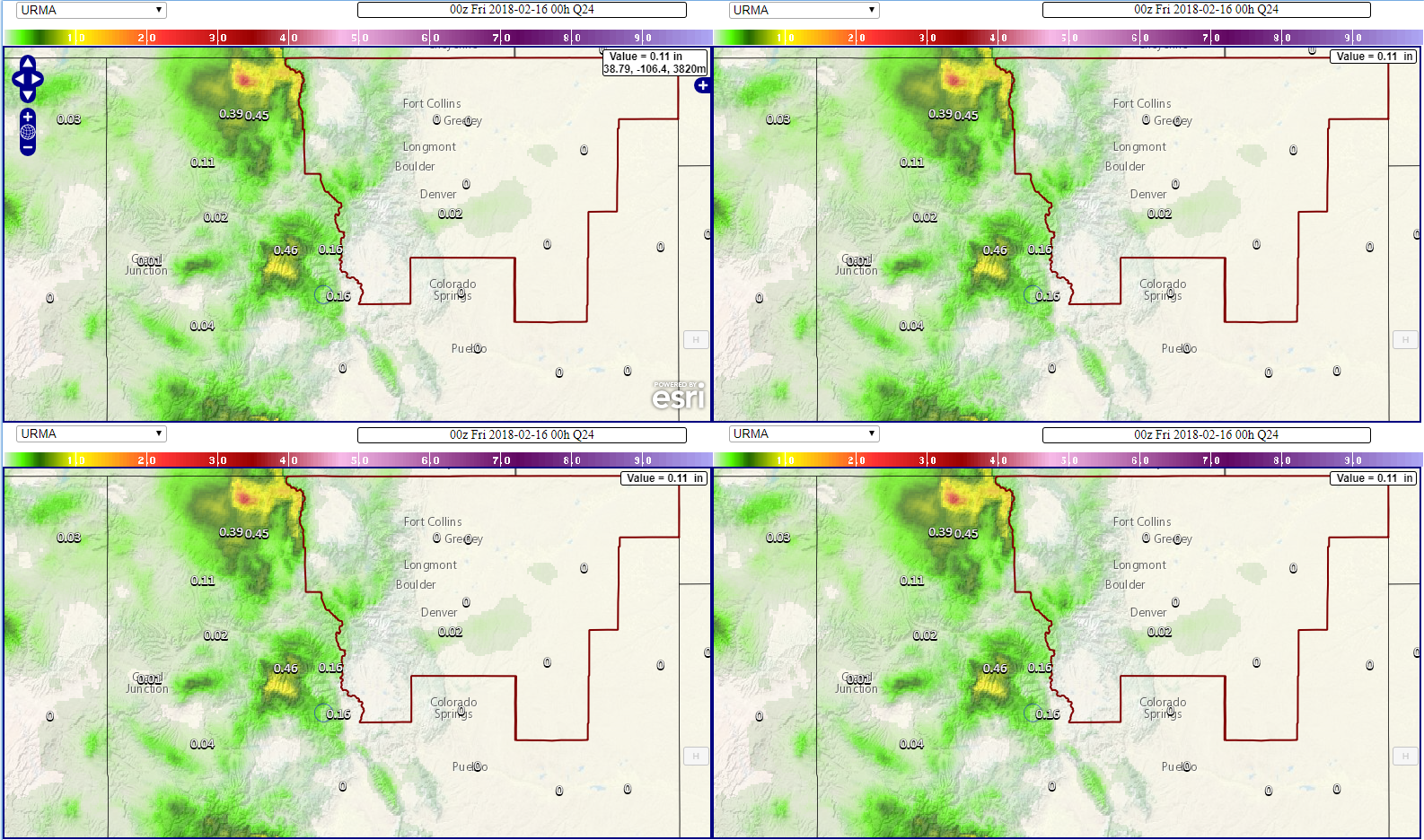All,
Resurrecting
this string of emails in the hopes of narrowing the list of
potential sources of the discontinuities in QPE. The state
of Colorado once again saw some pretty drastic differences
across RFC boundaries on 2/15. For the images in this email
I will focus on the Colorado RFC and Missouri RFC boundary
along the Park Range in northern Colorado. It's the western
border of Jackson County, eastern border of Routt County,
bordered on the north by Wyoming. On Feb 15th a nice snow
event hit northern Colorado. First, the AHPS 24 hr QPE for
the 15th:
Next,
the AHPS QPE for the 16th. Note that most of the QPE fell
from 00Z on the 15th through 00Z on the 16th, but AHPS
doesn't allow 24hr amounts from 00Z to 00Z, so you'll have
to mentally add the 2 images.

The
Park Range is the N-S oriented high QPE that starts at the
Wyoming border in the top center of both images. Notice
that pretty good QPE extends east of the max. For west
upslope events, the max in snowfall occurs along the terrain
gradient on the west side up to the ridge tops, but a lot of
QPE "blows over" to the east, sometimes all the way to the
valley floor in central Jackson County. Granted, it's FAR
less in places like Walden but on the east slopes of the
Park Range, high QPE can still occur. In fact, a CoCoRAHS
observer on the east side of Jackson County (well east of
the traditional max along the ridge top) had 0.60 liquid
from 12Z 2-15 to 12Z 2-16. All that said, these AHPS
graphics seem to capture the real QPE patterns and amounts
well for northern Colorado. Keep this in mind when you look
at the URMA graphics next.
First,
what we get in GFE. We have 6 hour grids for URMA QPE.
This is a loop of the last 6 days of QPE. You'll notice
that at 06Z on 2-15 there is high QPE Park Range for the
Colorado RFC side of the mountains but nothing on the
Missouri RFC side. This pattern of higher QPE in Colorado
RFC vs. very little for Missouri RFC continues until 18Z on
the 15th. The east slopes of Jackson into the north park
area of Jackson county never see any QPE for this event in
URMA, despite a good amount shown in AHPS. Again we feel
AHPS is accurate while the URMA QPE for this event is not.
Finally,
from the Veritas website the 24 QPE ending at 06Z 2-16 is
shown below.

I chose 06-06Z because that was the bulk of the precip
event in Jackson County. 00Z to 00Z would have shown pretty
much the same thing here. What it shows again matches what
we have for URMA in GFE. It is in stark contrast to AHPS
QPE. It's clear this URMA image is not taking advantage of
CoCoRAHS and the 0.60 amount 5-10 miles east of the max
QPE. Further east, across the Medicine Bow Mountains
(eastern Jackson County/Western Larimer County west of Ft
Collins) where AHPS has 0.3-0.6 total across the 2 days,
URMA has 0.05 to 0.1. I am not saying which is more correct
in the Medicine Bows because there are very few obs there,
and no CoCoRAHS obs at all.
The
question remains: Is URMA using the best available
QPE from the Missouri Basin RFC? Seems as though the AHPS
page QPE has higher quality data for our mountain sites
across northern Colorado. On the Colorado RFC side of our
area the URMA amounts look more realistic and in line with
observations.
Thanks,
Paul